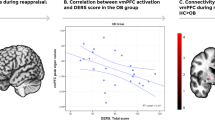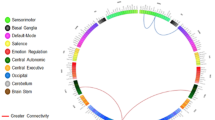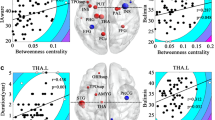Abstract
Objectives:
The neurobiological mechanisms linking obesity to emotional distress remain largely undiscovered.
Methods:
In this pilot study, we combined positron emission tomography, using the norepinephrine transporter (NET) tracer [11C]-O-methylreboxetine, with functional connectivity magnetic resonance imaging, the Beck depression inventory (BDI), and the impact of weight on quality of life–Lite questionnaire (IWQOL–Lite), to investigate the role of norepinephrine in the severity of depression (BDI), as well as in the loss of emotional well-being with body weight (IWQOL–Lite).
Results:
In a small group of lean-to-morbidly obese individuals (n=20), we show that an increased body mass index (BMI) is related to a lowered NET availability within the hypothalamus, known as the brain’s homeostatic control site. The hypothalamus displayed a strengthened connectivity in relation to the individual hypothalamic NET availability to the anterior insula/frontal operculum, as well as the medial orbitofrontal cortex, assumed to host the primary and secondary gustatory cortex, respectively (n=19). The resting-state activity in these two regions was correlated positively to the BMI and IWQOL–Lite scores, but not to the BDI, suggesting that the higher the resting-state activity in these regions, and hence the higher the BMI, the stronger the negative impact of the body weight on the individual’s emotional well-being was.
Conclusions:
This pilot study suggests that the loss in emotional well-being with weight is embedded within the central norepinephrine network.
This is a preview of subscription content, access via your institution
Access options
Subscribe to this journal
Receive 12 print issues and online access
$259.00 per year
only $21.58 per issue
Buy this article
- Purchase on Springer Link
- Instant access to full article PDF
Prices may be subject to local taxes which are calculated during checkout




Similar content being viewed by others
References
Hollmann M, Hellrung L, Pleger B, Schlogl H, Kabisch S, Stumvoll M et al. Neural correlates of the volitional regulation of the desire for food. Int J Obesity 2012; 36: 648–655.
Raji CA, Ho AJ, Parikshak NN, Becker JT, Lopez OL, Kuller LH et al. Brain structure and obesity. Hum Brain Mapp 2010; 31: 353–364.
Cortese S, Angriman M, Maffeis C, Isnard P, Konofal E, Lecendreux M et al. Attention-deficit/hyperactivity disorder (ADHD) and obesity: a systematic review of the literature. Crit Rev Food Sci Nutr 2008; 48: 524–537.
Gunstad J, Paul RH, Cohen RA, Tate DF, Spitznagel MB, Gordon E . Elevated body mass index is associated with executive dysfunction in otherwise healthy adults. Compr Psychiatry 2007; 48: 57–61.
Fotuhi M, Hachinski V, Whitehouse PJ . Changing perspectives regarding late-life dementia. Nat Rev Neurol 2009; 5: 649–658.
McElroy SL, Kotwal R, Malhotra S, Nelson EB, Keck PE, Nemeroff CB . Are mood disorders and obesity related? A review for the mental health professional. J Clin Psychiatry 2004; 65: 634–651; quiz 730.
Dong C, Sanchez LE, Price RA . Relationship of obesity to depression: a family-based study. Int J Obes Relat Metab Disord 2004; 28: 790–795.
Li CS, Potenza MN, Lee DE, Planeta B, Gallezot JD, Labaree D et al. Decreased norepinephrine transporter availability in obesity: Positron Emission Tomography imaging with (S,S)-[(11)C]O-methylreboxetine. Neuroimage 2014; 86: 306–310.
Fitzgerald PJ . Elevated norepinephrine may be an etiological factor in a wide range of diseases: age-related macular degeneration, systemic lupus erythematosus, atrial fibrillation, metabolic syndrome. Med Hypotheses 2013; 80: 558–563.
Smeets PA, Charbonnier L, van Meer F, van der Laan LN, Spetter MS . Food-induced brain responses and eating behaviour. Proc Nutr Soc 2012; 71: 511–520.
Heal DJ, Aspley S, Prow MR, Jackson HC, Martin KF, Cheetham SC . Sibutramine: a novel anti-obesity drug. A review of the pharmacological evidence to differentiate it from d-amphetamine and d-fenfluramine. Int J Obes Relat Metab Disord 1998; 22: S18–S28 discussion S29.
Adan RA, Vanderschuren LJ, la Fleur SE . Anti-obesity drugs and neural circuits of feeding. Trends Pharmacol Sci 2008; 29: 208–217.
Schildkraut JJ . The catecholamine hypothesis of affective disorders: a review of supporting evidence. Am J Psychiatry 1965; 122: 509–522.
Klimek V, Stockmeier C, Overholser J, Meltzer HY, Kalka S, Dilley G et al. Reduced levels of norepinephrine transporters in the locus coeruleus in major depression. J Neurosci 1997; 17: 8451–8458.
Goddard AW, Ball SG, Martinez J, Robinson MJ, Yang CR, Russell JM et al. Current perspectives of the roles of the central norepinephrine system in anxiety and depression. Depress Anxiety 2010; 27: 339–350.
Gallezot JD, Weinzimmer D, Nabulsi N, Lin SF, Fowles K, Sandiego C et al. Evaluation of [(11)C]MRB for assessment of occupancy of norepinephrine transporters: Studies with atomoxetine in non-human primates. Neuroimage 2011; 56: 268–279.
Ding YS, Lin KS, Logan J, Benveniste H, Carter P . Comparative evaluation of positron emission tomography radiotracers for imaging the norepinephrine transporter: (S,S) and (R,R) enantiomers of reboxetine analogs ([11C]methylreboxetine, 3-Cl-[11C]methylreboxetine and [18 F]fluororeboxetine), (R)-[11C]nisoxetine, [11C]oxaprotiline and [11C]lortalamine. J Neurochem 2005; 94: 337–351.
Ding YS, Singhal T, Planeta-Wilson B, Gallezot JD, Nabulsi N, Labaree D et al. PET imaging of the effects of age and cocaine on the norepinephrine transporter in the human brain using (S,S)-[(11)C]O-methylreboxetine and HRRT. Synapse 2010; 64: 30–38.
Beck AT, Steer RA, Brown GK . Manual for the Beck Depression Inventory-II. Physiological Corporation: San Antonio, TX, USA, 1996.
Kolotkin RL, Crosby RD, Kosloski KD, Williams GR . Development of a brief measure to assess quality of life in obesity. Obes Res 2001; 9: 102–111.
Ding YS, Lin KS, Garza V, Carter P, Alexoff D, Logan J et al. Evaluation of a new norepinephrine transporter PET ligand in baboons, both in brain and peripheral organs. Synapse 2003; 50: 345–352.
Innis RB, Cunningham VJ, Delforge J, Fujita M, Gjedde A, Gunn RN et al. Consensus nomenclature for in vivo imaging of reversibly binding radioligands. J Cereb Blood Flow Metab 2007; 27: 1533–1539.
Ichise M, Liow JS, Lu JQ, Takano A, Model K, Toyama H et al. Linearized reference tissue parametric imaging methods: application to [11C]DASB positron emission tomography studies of the serotonin transporter in human brain. J Cereb Blood Flow Metab 2003; 23: 1096–1112.
Maldjian JA, Laurienti PJ, Kraft RA, Burdette JH . An automated method for neuroanatomic and cytoarchitectonic atlas-based interrogation of fMRI data sets. Neuroimage 2003; 19: 1233–1239.
Small DM, Zald DH, Jones-Gotman M, Zatorre RJ, Pardo JV, Frey S et al. Human cortical gustatory areas: a review of functional neuroimaging data. Neuroreport 1999; 10: 7–14.
O'Doherty J, Rolls ET, Francis S, Bowtell R, McGlone F . Representation of pleasant and aversive taste in the human brain. J Neurophysiol 2001; 85: 1315–1321.
Ho A, Kennedy J, Dimitropoulos A . Neural correlates to food-related behavior in normal-weight and overweight/obese participants. PLoS One 2012; 7: e45403.
Rothemund Y, Preuschhof C, Bohner G, Bauknecht HC, Klingebiel R, Flor H et al. Differential activation of the dorsal striatum by high-calorie visual food stimuli in obese individuals. Neuroimage 2007; 37: 410–421.
Kolotkin RL, Crosby RD . Psychometric evaluation of the impact of weight on quality of life-lite questionnaire (IWQOL-lite) in a community sample. Qual Life Res 2002; 11: 157–171.
Sirtori A, Brunani A, Villa V, Berselli ME, Croci M, Leonardi M et al. Obesity is a marker of reduction in QoL and disability. Sci World J 2012; 2012: 167520.
Ayloo S, Thompson K, Choudhury N, Sheriffdeen R . Correlation between the Beck Depression Inventory and bariatric surgical procedures. Surg Obes Relat Dis 2014; 11: 637–642.
Jarmolowicz DP, Cherry JB, Reed DD, Bruce JM, Crespi JM, Lusk JL et al. Robust relation between temporal discounting rates and body mass. Appetite 2014; 78: 63–67.
Palinkas LA, Wingard DL, Barrett-Connor E . Depressive symptoms in overweight and obese older adults: a test of the "jolly fat" hypothesis. J Psychosom Res 1996; 40: 59–66.
Veldhuizen MG, Albrecht J, Zelano C, Boesveldt S, Breslin P, Lundstrom JN . Identification of human gustatory cortex by activation likelihood estimation. Hum Brain Mapp 2011; 32: 2256–2266.
Kolotkin RL, Crosby RD, Williams GR, Hartley GG, Nicol S . The relationship between health-related quality of life and weight loss. Obes Res 2001; 9: 564–571.
Boan J, Kolotkin RL, Westman EC, McMahon RL, Grant JP . Binge eating, quality of life and physical activity improve after Roux-en-Y gastric bypass for morbid obesity. Obes Surg 2004; 14: 341–348.
Zatorre RJ, Jones-Gotman M, Evans AC, Meyer E . Functional localization and lateralization of human olfactory cortex. Nature 1992; 360: 339–340.
Rolls ET, Scott TR, Sienkiewicz ZJ, Yaxley S . The responsiveness of neurones in the frontal opercular gustatory cortex of the macaque monkey is independent of hunger. J Physiol 1988; 397: 1–12.
Weltens N, Zhao D, Van Oudenhove L . Where is the comfort in comfort foods? Mechanisms linking fat signaling, reward, and emotion. Neurogastroenterol Motil 2014; 26: 303–315.
Rolls ET . Brain mechanisms underlying flavour and appetite. Philos Trans R Soc Lond B Biol Sci 2006; 361: 1123–1136.
Rolls ET . Understanding the mechanisms of food intake and obesity. Obes Rev 2007; 8: 67–72.
Grabenhorst F, Rolls ET . Selective attention to affective value alters how the brain processes taste stimuli. Eur J Neurosci 2008; 27: 723–729.
Berthoud HR, Lenard NR, Shin AC . Food reward, hyperphagia, and obesity. Am J Physiol Regul Integr Comp Physiol 2011; 300: R1266–R1277.
Kringelbach ML . Food for thought: hedonic experience beyond homeostasis in the human brain. Neuroscience 2004; 126: 807–819.
Berridge KC, Kringelbach ML . Affective neuroscience of pleasure: reward in humans and animals. Psychopharmacology 2008; 199: 457–480.
Rolls ET, Grabenhorst F . The orbitofrontal cortex and beyond: from affect to decision-making. Prog Neurobiol 2008; 86: 216–244.
Grabenhorst F, Rolls ET, Parris BA, d'Souza AA . How the brain represents the reward value of fat in the mouth. Cerebral cortex 2010; 20: 1082–1091.
Grabenhorst F, Rolls ET . Value, pleasure and choice in the ventral prefrontal cortex. Trends Cogn Sci 2011; 15: 56–67.
Zheng H, Lenard NR, Shin AC, Berthoud HR . Appetite control and energy balance regulation in the modern world: reward-driven brain overrides repletion signals. Int J Obes 2009; 33: S8–13.
Ganley RM . Emotion and eating in obesity: a review of the literature. Int J Eat Disorder 1989; 8: 343–361.
Cooper PJ, Taylor MJ, Cooper Z, Fairbum CG . The development and validation of the Body Shape Questionnaire. Int J Eat Disorder 1987; 6: 485–494.
Grilo CM, Wilfley DE, Brownell KD, Rodin J . Teasing, body image, and self-esteem in a clinical sample of obese women. Addict Behav 1994; 19: 443–450.
Atlantis E, Ball K . Association between weight perception and psychological distress. Int J Obes 2008; 32: 715–721.
Polivy J, Herman CP . Distress and eating: why do dieters overeat? Int J Eat Disorder 1999; 26: 153–164.
Patel KA, Schlundt DG . Impact of moods and social context on eating behavior. Appetite 2001; 36: 111–118.
Greeno CG, Wing RR . Stress-induced eating. Psychol Bull 1994; 115: 444–464.
Macht M, Haupt C, Ellgring H . The perceived function of eating is changed during examination stress: a field study. Eat Behav 2005; 6: 109–112.
Macht M, Simons G . Emotions and eating in everyday life. Appetite 2000; 35: 65–71.
Horstmann A, Busse FP, Mathar D, Muller K, Lepsien J, Schlogl H et al. Obesity-related differences between women and men in brain structure and goal-directed behavior. Front Hum Neurosci 2011; 5: 58.
Mueller K, Anwander A, Moller HE, Horstmann A, Lepsien J, Busse F et al. Sex-dependent influences of obesity on cerebral white matter investigated by diffusion-tensor imaging. PLoS One 2011; 6: e18544.
Administration UFaD. Meridia (sibutramine): market withdrawal due to risk of serious cardiovascular events. Retrieved 2010; 3: 2011.
Acknowledgements
This study is supported by the IFB Adiposity Diseases, Federal Ministry of Education and Research (BMBF), Germany, FKZ: 01E01001 (http://www.bmbf.de) and the German Research Foundation (DFG) (http://www.dfg.de), within the framework of the CRC 1052 Obesity Mechanisms (to project A6 and BP). We thank Shameem Wagner for proof reading the final version of this manuscript.
Author information
Authors and Affiliations
Corresponding author
Ethics declarations
Competing interests
The authors declare no conflict of interest.
Additional information
Supplementary Information accompanies this paper on International Journal of Obesity website
Rights and permissions
About this article
Cite this article
Melasch, J., Rullmann, M., Hilbert, A. et al. The central nervous norepinephrine network links a diminished sense of emotional well-being to an increased body weight. Int J Obes 40, 779–787 (2016). https://doi.org/10.1038/ijo.2015.216
Received:
Revised:
Accepted:
Published:
Issue Date:
DOI: https://doi.org/10.1038/ijo.2015.216
This article is cited by
-
Central Noradrenergic Neurotransmission and Weight Loss 6 Months After Gastric Bypass Surgery in Patients with Severe Obesity
Obesity Surgery (2021)
-
The interrelationship of body mass index with gray matter volume and resting-state functional connectivity of the hypothalamus
International Journal of Obesity (2020)
-
Noradrenaline transporter availability on [11C]MRB PET predicts weight loss success in highly obese adults
European Journal of Nuclear Medicine and Molecular Imaging (2018)
-
Central noradrenaline transporter availability in highly obese, non-depressed individuals
European Journal of Nuclear Medicine and Molecular Imaging (2017)
-
Sex differences in serotonin–hypothalamic connections underpin a diminished sense of emotional well-being with increasing body weight
International Journal of Obesity (2016)



